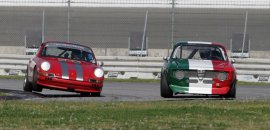Handbrake turnFrom TrackpediaThe handbrake turn is a simple technique, used in either stunt driving, or in hairpins in Rally driving. However, there is a bit more to this technique than simply pulling the handbrake. Actually, there are a lot of small details in this procedure, in spite of the fact it's done in one moment or so.
UseThe handbrake turn is most efficient in a sporty front wheel-drive car, though it will also work in a standart four-wheel drive. In times, it's used to induce a drift in a rear-wheel drive, or spin them alltoghether. The goal of this action has the practical use of getting the car around tight hairpins or corners in the narrowest space, tighter even than full steering lock. Additionally, it has a great show-off value in drifting and stunt driving, being a key part in the manouver of a spin or arabian drift. ApplicationIn order to do a handbrake turn, the car must be accurately percised. Don't try and take the racing line, as it would have you too close to the edge of the roadway. Instead, use the center of the roadway. Start off with a normal braking zone to match the speed and gear (normally a slower speed, first or second gear), enter the corner with trail braking and leave the steering for later, around about mid-corner. However, in this stage, just pulling on the handbrake isn't going to be enough. What you need to do is to unsettle the car by braking into the corner, leaning the weight of it forward and off of the rear wheels. It might be nessecary to apply the scandinavian flick beforehand to iritate the car even further. Now, having just entered the corner, a quick and relatively large steering input should be applied to steer the car around the corner. Most corners that require a handbrake turn allow to driver to operate the handbrake with one hand, and pull the steering wheel from across, rather than pushing it. The driver should relocate his hand across the wheel or on the bottom of the wheel, upside-down, and pulls all the way back to 3 O'Clock at once. At the split second after you begin to turn the wheel, you pull on the handbrake, with the ratchet button pressed in. The handbrake can in most cases be pressed for a moment, but sometimes you might have to hold on to it longer. Once the car has rotated around most of the corner, go off of the handbrake. Take that hand across the wheel, and pull it back to 9 O'Clock, with the other hand letting the rim slip under it with control. At the same time when you steer and apply the handbrake, the brakes must still be feathered and the clutch must be engaged. As you exit the corner, release the clutch quickly, shift into first as nessecary, ideally spinning the front tires (in a FWD) for a moment, to balance to front and rear of the car. Than, apply the throttle progressively to power out, running wide. Common mistakes
External links
|
